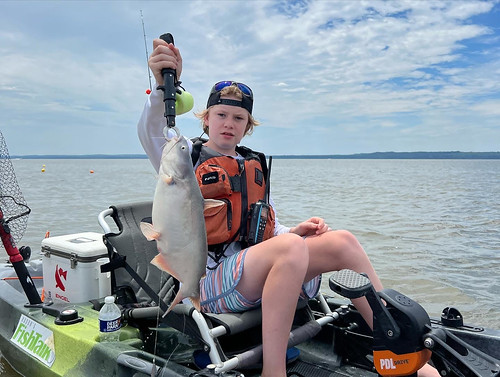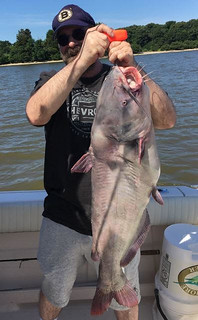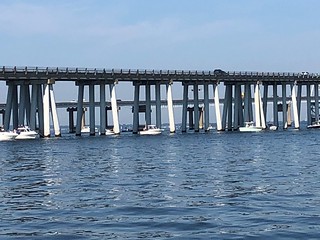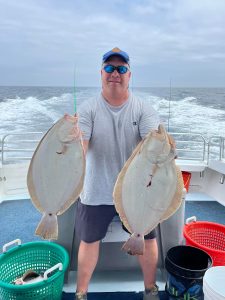Maryland Fishing Report – July 13
Kayak fishing has gained many converts in the past few years. These small, human-powered watercraft are portable and offer easy access to waters throughout Maryland, and for our younger anglers provide an opportunity to be the captain of their own vessel.
All Maryland areas of the Chesapeake Bay and its tidal tributaries will be closed to any targeting of striped bass – including catch-and-release and charter boats – starting Saturday July 16 through July 31. This conservation measure was enacted because hot weather and low oxygen this time of year creates tough conditions for striped bass to survive catch and release – and this high mortality impacts the future of our fishery. When the summer season resumes August 1, the Maryland Department of Natural Resources also will resume its striped bass fishing advisory forecast so anglers can better plan their fishing to lessen mortalities.
Forecast Summary: July 13 – July 19:
Sunny, warm, and relatively calm weather continues, with chances of rain Sunday through Tuesday. Mid-July water temperatures typically are the warmest of the year. Chesapeake Bay surface water temperatures have risen to the low 80s, and Maryland rivers are running in the mid-70s. Expect continued warming as the week progresses. If you are seeking areas with cooler waters, fish the surface early in the day, or fish deeper waters or upwind areas.
Coolest oxygenated bottom waters can be found from about Kent Island north to near Tolchester. At the following locations, adequate oxygen conditions can be found from the surface to these depths: from the Virginia state line up to the Gooses Reef buoy, 40 feet to the bottom; Little Choptank up to the Choptank River, 25 feet to bottom; Bloody Point, 20 feet to 25 feet; Bay Bridge, 15 feet to 25 feet; Swan Point, 25 feet; and Still Pond up to the Susquehanna Flats, surface to bottom. Poor deep water oxygen conditions are present in most tributaries, where there is adequate oxygen down to about 20 feet. On the Potomac River, there is adequate oxygen down to 15 feet from the 301 Bridge downriver to Breton Beach. It is likely that in most locations, gamefish will be deeper in the water column to find adequate oxygen and their preferred water temperatures. In addition, if you are seeking areas with cooler waters in your area, fish surface waters early in the day, or find deeper waters and upwind areas.
Expect average flows for most Maryland rivers and streams all week, but higher flows in the Potomac River watershed. There will be above average tidal currents all week because of the upcoming full moon July 13-14.
There will be average water clarity for most of the main Bay as well as many rivers and streams. To see the latest water clarity conditions, check Eyes on the Bay Satellite Maps on the Maryland Department of Natural Resources website.
As always, best fishing areas could be further refined by intersecting them with underwater points, hard bottom, drop-offs, and large schools of baitfish.
For more detailed and up-to-date fishing conditions in your area of the Bay, be sure to check out Eyes on the Bay’s Click Before You Cast.
Striped bass have been sparse at the Conowingo Dam pool and the lower Susquehanna River. A few are being caught in the early morning and late evening hours on topwater lures and paddletails. Along the edges of the Susquehanna Flats anglers are catching a mix of largemouth bass and snakeheads in or along the edges of the grass.
Fishing for striped bass has been very good in the area from Pooles Island to Tolchester, on the various lumps and knolls there, however, keep in mind that the season will close for two weeks, starting on July 16. Consider an alternate species that you can target. If you are getting out before closure, Swan Point and the Love Point rocks are also excellent places for live-lining spot this week, and could be a productive alternative to the Tolchester area. Most anglers are catching their spot in the Sandy Point area, and with the crowds that have been showing up at the lumps, it pays to have already caught your spot before leaving the dock for your fishing grounds. As one would expect there is crowding for the best spots. Many of the striped bass being caught are undersized and must be returned to the Bay, so please be familiar with responsible catch-and-release procedures and for tips on using circle hooks from the DNR website.
Jigging for striped bass is a good alternative to live-lining spot this week at the Love Point rocks and the Key Bridge piers. At the Love Point rocks a good tactic is to work your jig along the bottom in the “walk-the-dog” fashion as it sweeps along in an arch, until the jig is behind the boat – then try again. The Key Bridge piers also provide a great place to jig with bucktails dressed with a twistertail or a soft plastic jig, kept close to the pier bases. When striped bass can be spotted on depth finders suspended along channel edges, good jigging action can often be found. Trolling along channel edges with small Drone spoons behind inline weights, or umbrella rigs behind heavy inline weights, can be an option this week. The striped bass are holding deep so it takes some weight to get lures down to the fish. White bucktails and sassy shads tend to be popular, as are gold Drone spoons.
Flathead catfish are being caught in the Conowingo Dam pool, with a mix of blue and channel catfish in the lower Susquehanna River, surrounding tidal rivers, and in the upper Bay. Fresh cut bait of gizzard shad, menhaden, or white perch works well for flatheads lining up in the turbine wash at the dam pool. Live-lining white perch, suckers, gizzard shad, or sunfish is another great way to target large flatheads in the dam pool or river. Cut baits, chicken livers, clam snouts, and a host of other delectable baits will work just fine for blue and channel catfish.
White perch are being caught in the region’s tidal rivers this week. Many anglers are fishing with bottom rigs baited with grass shrimp or pieces of bloodworm in the deeper waters near channel edges and structure such as bridge and dock piers. Others are enjoying light tackle fun by casting spinners and small jigs along shoreline structure in the morning and evening hours.
The Bay Bridge eastern side piers are getting a lot of attention from anglers before the two-week striped bass closure July 16-31. It pays to get there early, and a good running tide is very important. Some boats are anchoring, while others use GPS-positioning electric bow motors for as long as batteries will last; or charter boat captains just keep the bow nosed into the current while slipping in and out of forward and neutral. Most anglers are drifting live spot back to the pier bases, but others are doing the same with cut menhaden, spot, and soft crabs.
Many of the striped bass being caught at the Bay Bridge fail to meet the 19-inch minimum and must be released. Anglers are urged to release sub-legal striped bass in the water if possible, to help them survive the strain of catch and release during the warm summer months. Please visit the DNR website and become familiar with responsible catch-and-release procedures and for tips on using circle hooks.
Jigging with bucktails and soft plastic jigs near the bases of the bridge piers is a fun endeavor for light-tackle anglers during the early morning or late evening hours. Jigs and bucktails should be cast as close to the piers as possible – if you’re not chipping paint off jig heads, you’re not casting close enough. Bucktails do well with twistertails attached, and soft plastic jigs with skirts can also up the odds.
Casting a mix of topwater lures and white paddletails along the shores of the Bay and lower tidal rivers during the early morning and late evening hours is a great way to fish for striped bass. There are few things in the fishing world as exciting as watching a fish go after a popper. Topwater lures really come into their own when fished over grass, while paddletails, jerkbaits, and crankbaits are good choices in deeper waters near shoreline structure. Speckled trout are becoming part of the shallow water mix this week and providing anglers with some additional excitement. It is not uncommon to hook into a snakehead in the lower parts of the tidal rivers. Both snakehead and spotted sea trout will be good alternative target species for anglers during the second half of July during the striped bass closure.
Fishing for white perch offers fun summertime action for anglers young and old. The white perch are holding in the region’s tidal rivers and creeks, often near structure. Docks and wharfs over deeper waters, fallen trees and sunken wood, old sunken rip rap, and oyster bars all tend to attract white perch. Fishing with a simple bottom rig baited with grass shrimp or pieces of bloodworm will do the trick in deeper waters. In the morning and evening hours, casting small spinners or jigs near shoreline structure is a great way to enjoy some light-tackle action.
The region’s tidal rivers are holding a mix of channel catfish and blue catfish. They are relatively easy to catch on cut bait or a variety of prepared baits. They tend to be holding along channel edges. The channel catfish can be found throughout the tidal rivers and the blue catfish tend to be in the lower sections of the rivers.
While the Maryland portion of the Chesapeake Bay and its tidal rivers will be closed to all striped bass fishing July 16-31, and the Potomac River is already closed to all striped bass fishing through August 20, the lower Bay offers plenty of other fishing opportunities.
Speckled trout and small bluefish are part of the mix when casting along the shorelines of the Bay and tidal rivers. The shores on the eastern side of the Bay and Tangier Sound hold the greatest chance for speckled trout and the least for striped bass.
Some of the best striped bass fishing prior to the two-week closurehas been found in the early morning and late evening hours by those casting a mix of topwater lures, crankbaits, and paddletails along the deep-water shores of the lower Patuxent River, Cedar Point, the cuts through Hoopers Island, and various Bay shore areas.
Live-lining spot is an effective way to fish for striped bass along channel edges. When concentrations of fish can be located, jigging with soft plastics is also a fun way to fish. Striped bass can also be found spread out along the edges of the shipping channel suspended at about 30 feet, and at the major channel leading out of the Patuxent River. Most are trolling with umbrella rigs pulled behind inline weights to get them down to the depths where striped bass are holding. Bucktails dressed with white sassy shads or twistertails are popular. With small bluefish entering the lower Bay, pulling a couple of small Drone spoons higher in the water column can provide some extra action. At least one Spanish mackerel was caught this week by trolling near the Virginia state line, and hopefully more will be arriving soon.
Fishing for white perch is good this week in the tidal rivers and creeks of the lower Bay. Fishing with bottom rigs baited with grass shrimp or pieces of bloodworm over oyster bars, off deep-water docks and piers, or near bridge piers works well. Those who can get out in the early morning and late evening hours are enjoying fun light-tackle action by casting small spinners and jigs near shoreline structure.
Cobia are providing action near Smith Point this week. The bulk of the cobia remain farther south but each week more are showing up close to Maryland waters. Chumming and drifting with live eels back in the chum slick is the most popular way anglers are targeting cobia. Drifting cut bait can be difficult with cownose rays being attracted to chum.
Blue catfish are providing plenty of action in the tidal Potomac, Patuxent, and Nanticoke rivers, and they can also be found to a lesser degree in the Wicomico River on the Eastern Shore. Fishing cut bait or a variety of other favored baits along channel edges is the most popular way to fish. Some anglers are increasing the odds by setting up a chum slick.
Recreational crabbing has certainly taken a turn for the better in the past week for those using collapsible crab traps or trotlines. It is not uncommon to catch a full bushel of crabs by those who are experienced. Many crabbers are reporting small crabs on their trotlines which is good news for later this summer. There are good reports of catches from the upper Bay down to the lower Bay this week.

Mike Heller caught and released this nice largemouth bass recently at Liberty Reservoir. Photo by Mike Heller
The western region continues to provide excellent trout fishing for those who love fly fishing and practicing catch and release. The trout management waters allocated to this type of fishing are providing some fun opportunities. Floating dry flies on a cool mountain stream or river must be one of the ultimate joys for fly fishing anglers. The upper Gunpowder River in the central region is another trout management water geared to this type of fishing.
The upper Potomac River is running low and clear this week, which often means anglers will be making long casts with light lines to catch wary smallmouth bass. The early morning and late evening hours offer some of the best fishing opportunities for smallmouth bass. Casting topwater lures and a mix of tubes, small crankbaits and swim shad jigs are some of the top choices for lures. The shallower areas of the river are thick with grass and fishing the edges, current breaks, and underwater ledges and large boulders offer some of the best opportunities.
Deep Creek Lake offers a wide variety of fishing options and most of them occur very early in the morning. Largemouth bass can be found along the shallower areas, and later in the day they will be seeking shade under floating docks and thick grass. Smallmouth bass can often be found on rocky points and under floating docks during the heat of the day. Yellow perch and smallmouth bass can also be found along deep-water grass edges – drifting with live minnows down deep is a good way to fish for them.
Largemouth bass are now holding in a typical summer pattern of behavior, feeding in the shallows at night and seeking shade during the day. The early morning and late evening hours hold some of the best fishing near the shallows with topwater lures, lipless crankbaits, and soft plastics. Largemouth bass will often retreat to deeper waters near structure or under floating grass. Working wacky rigged plastic baits through grass or near structure is a good tactic.
Northern snakeheads will be part of the mix when fishing shallow waters with frogs, buzzbaits, or chatterbaits. The tidal rivers and creeks of the Chesapeake all hold populations of snakeheads. The tidal Potomac, Patuxent, and Nanticoke rivers, and lower Dorchester County hold some of the most concentrated populations. Biologists have tagged a number of northern snakeheads in Maryland waters to determine population movement and angler success and are offering rewards for tag returns. To learn more information about this program, visit the DNR website.
Surf anglers fishing large baits are catching and releasing large red drum now and then. There was a northerly movement of large red drum through our waters last week and there are still a few fish moving along the beaches. Cownose rays and small inshore sharks will also be part of the mix when fishing large cut baits. Anglers fishing with bloodworms are catching kingfish and flounder, and blowfish are being caught on squid. Small bluefish are being caught on cut bait or finger mullet.
At the inlet, a few large sheepshead are being caught by those fishing with sand fleas. Flounder are being caught on Gulp baits, squid, and minnows. Bluefish are being caught by drifting cut bait or by jigging and casting. A few striped bass are also being caught in the early morning and late evenings near bridge piers, jetty rocks, and bulkheads. In the back bay channels, flounder fishing has been good for those drifting squid and minnows along the bottom or by jigging with Gulp baits.
Outside the inlet and relatively close to shore, Spanish mackerel are being caught by trolling small Drone and Clark spoons behind inline weights. Farther out, the boats anchoring over the wreck and reef sites are finding good fishing for black sea bass.
Offshore at the canyons, the big focus was on tuna during the Ocean City Tuna Tournament. Some impressive bigeye tuna were landed, along with a nice array of yellowfin tuna. Deep-drop fishing continues to bring fish onboard for anglers, and blueline tilefish tend to be the main target. As a reminder, the shortfin mako fishery closed July 5.
“Nick did not like to fish with other men on the river. Unless they were of your party, they spoiled it.” – Ernest Hemingway
Maryland Fishing Report is written and compiled by Keith Lockwood, fisheries biologist with the Maryland Department of Natural Resources.
Click Before You Cast is written by Tidewater Ecosystem Assessment Director Tom Parham.
This report is now available on your Amazon Echo device — just ask Alexa to “open Maryland Fishing Report.”







 1-888-373-7888
1-888-373-7888 233733
233733